Featured Comment:
“This is the best oyakodon recipe ever. Problem solved! And I have tried many. Before, the chicken turned out too hard, too blonde, too dry, or onions too dark, too strong, too something, the dashi too much too little, the egg too raw too cooked. Too many toos with little possibility to control the end result in the making. Now this here is the ultimate answer.”
– Isa
What is Oyakodon?
Oyakodon (親子丼) is the ultimate Japanese comfort bowl. The name “parent and child” (oyako) might sound odd at first, but it perfectly captures the chicken-and-egg relationship at the heart of this dish.
It’s got tender chicken and sweet onions simmered in a gently seasoned dashi broth, then swirled with softly set eggs before sliding onto hot steamed rice. In 25 minutes, you’ll have this ultimate one-pan meal whose sweet-savory sauce seeps into every grain, turning any kitchen into a taste of Japan.
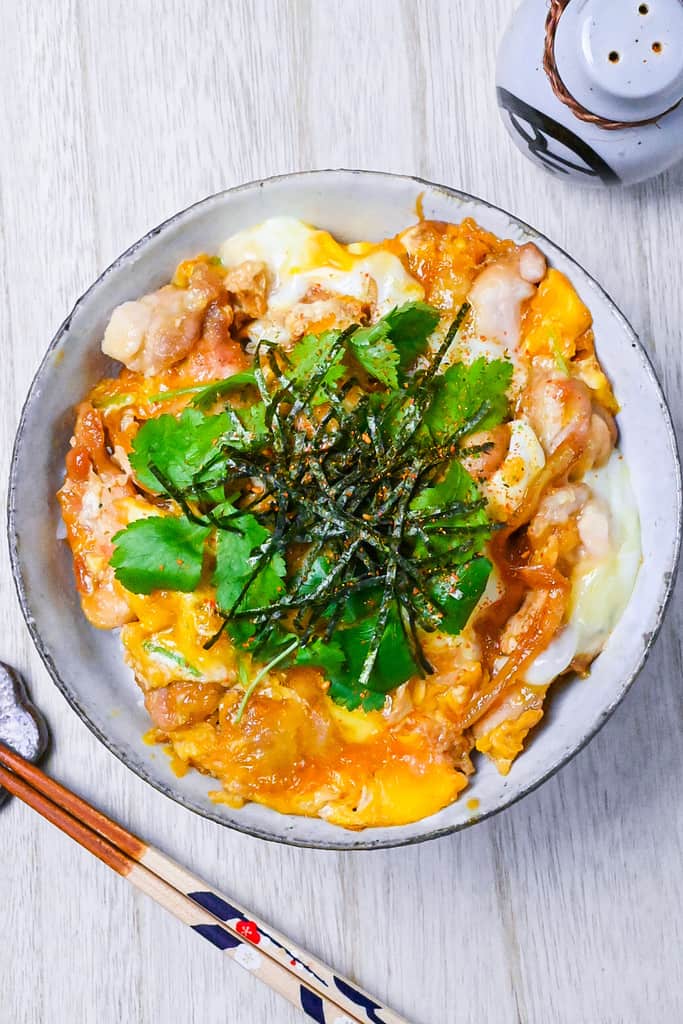
It’s a dish that’s as comforting as it is simple: no deep-frying, no hard-to-find condiments. Just Japanese staple ingredients meeting classic Japanese technique. No matter if you’re getting through a busy weekday or battling a wave of homesickness, this bowl will give you restaurant-level satisfaction without the hassle.
Fun fact: swap the chicken for pork, and you’ve got “Tanindon” (literally “strangers in a bowl),” since pork and egg aren’t related.
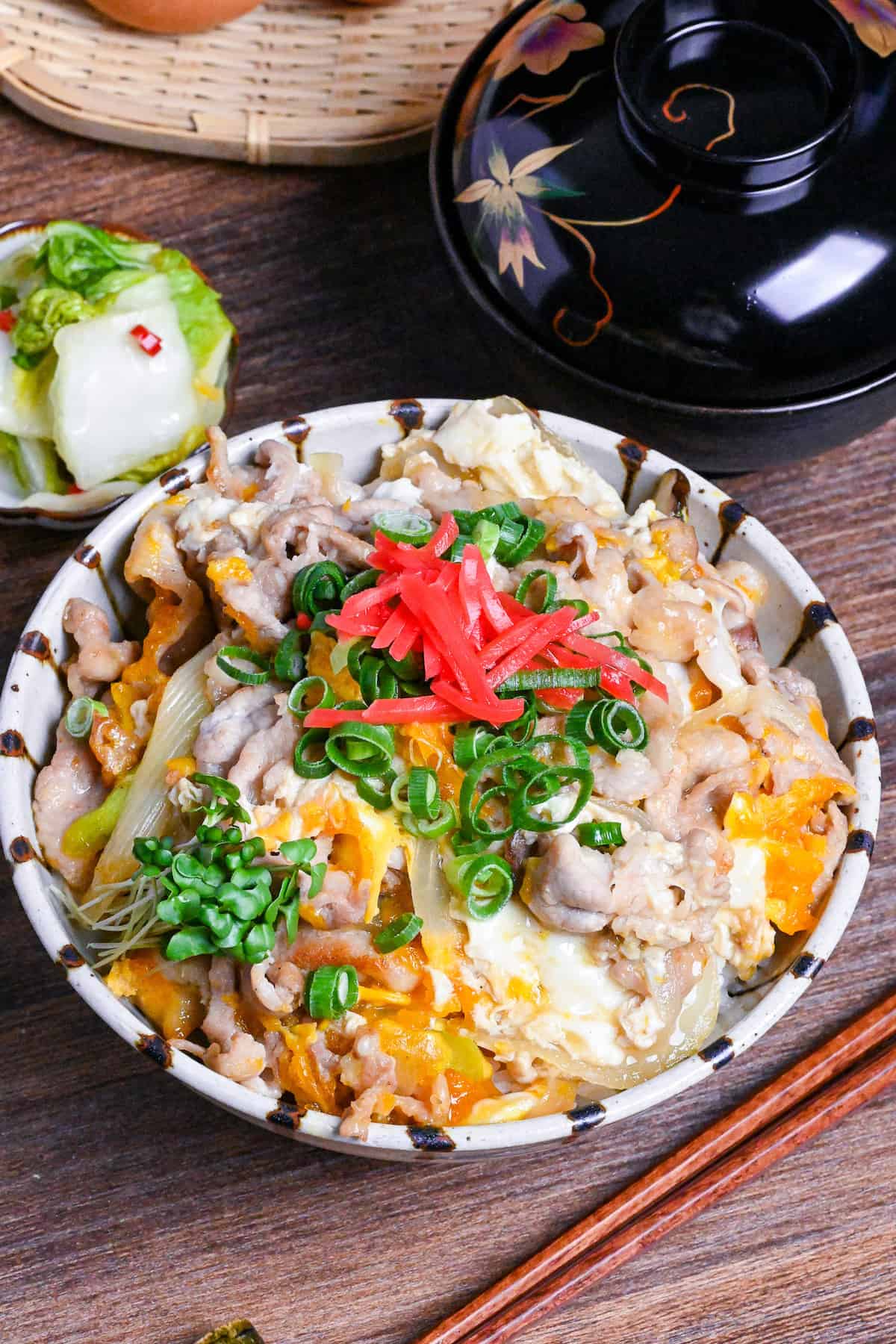
Visual Walkthrough & Tips
Here are my step-by-step instructions for how to make delicious and comforting Japanese Oyakodon at home. For ingredient quantities and simplified instructions, scroll down for the Printable Recipe Card below.
If you prefer to watch the process in action, check out my YouTube video of this Oyakodon recipe for a complete visual walkthrough!
Begin by cutting the chicken thigh into bite-sized pieces after patting the surface dry with paper towels. Season generously with salt. Lightly dredge the chicken in flour, using just enough to create a thin, even coating.
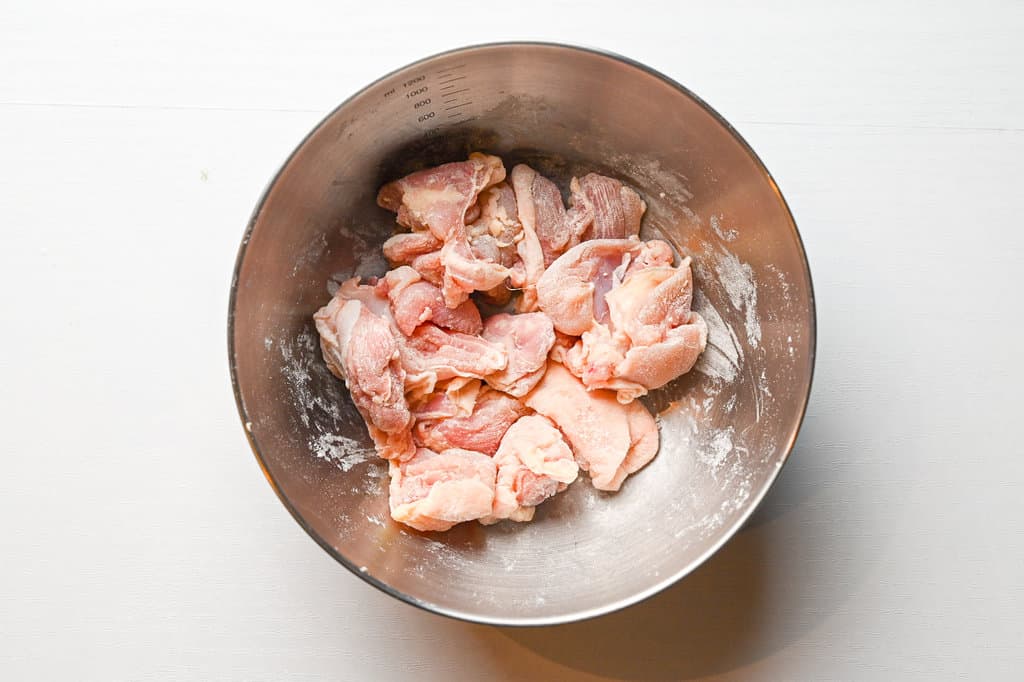
The flour coating helps promote the Maillard reaction, which creates a golden crust. This also keeps the meat from releasing too much liquid into the sauce later.
Just be careful not to overdo it with the flour, or you might end up with a gummy texture.
Heat up a large frying pan over medium heat and add a bit of cooking oil. When the oil shimmers but doesn’t smoke, put the chicken pieces in a single layer, skin-side down. Let them cook undisturbed for 2-3 minutes until golden brown and crispy.
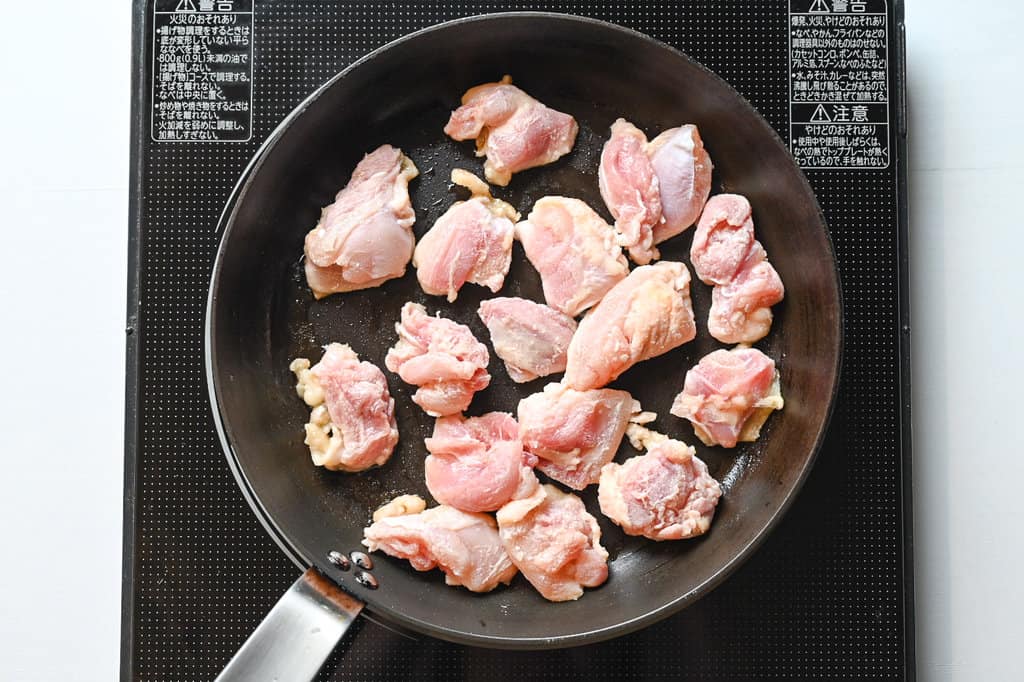
Chicken proteins begin to coagulate at 58-60°C (136-140°F). By starting with medium heat, you allow the interior to warm gradually while the exterior develops proper color.
Too high heat causes rapid protein denaturation, resulting in tough, dry meat.
Flip each piece and sear briefly on the other side.
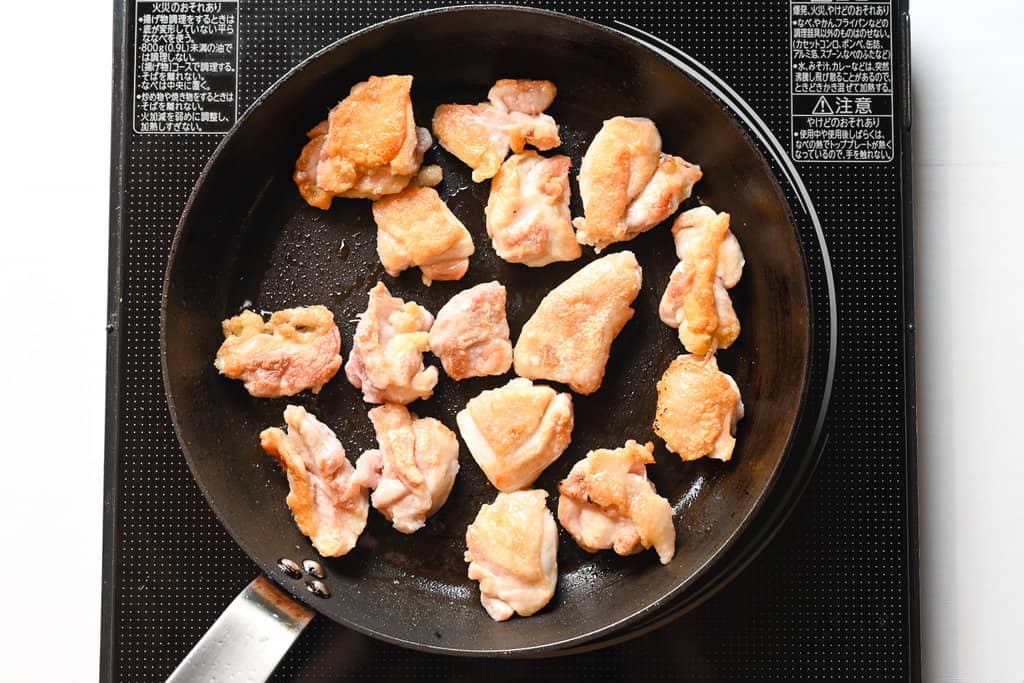
At this point, the chicken doesn’t need to be fully cooked. Just put it on a plate, and the residual heat will continue cooking it gently.
This two-step method makes sure the meat is tender and won’t overcook when you simmer it in sauce.
We’re going to reuse the pan, so use paper towels to wipe up the excess oil. Next, add dashi stock, mirin, light brown sugar, and Chinese chicken bouillon powder.
Add onions cut into thin wedges and simmer until translucent and sweet. Slow cooking breaks down the cell walls, releasing natural sugars while creating a soft, melt-in-your-mouth texture that complements the custardy eggs.
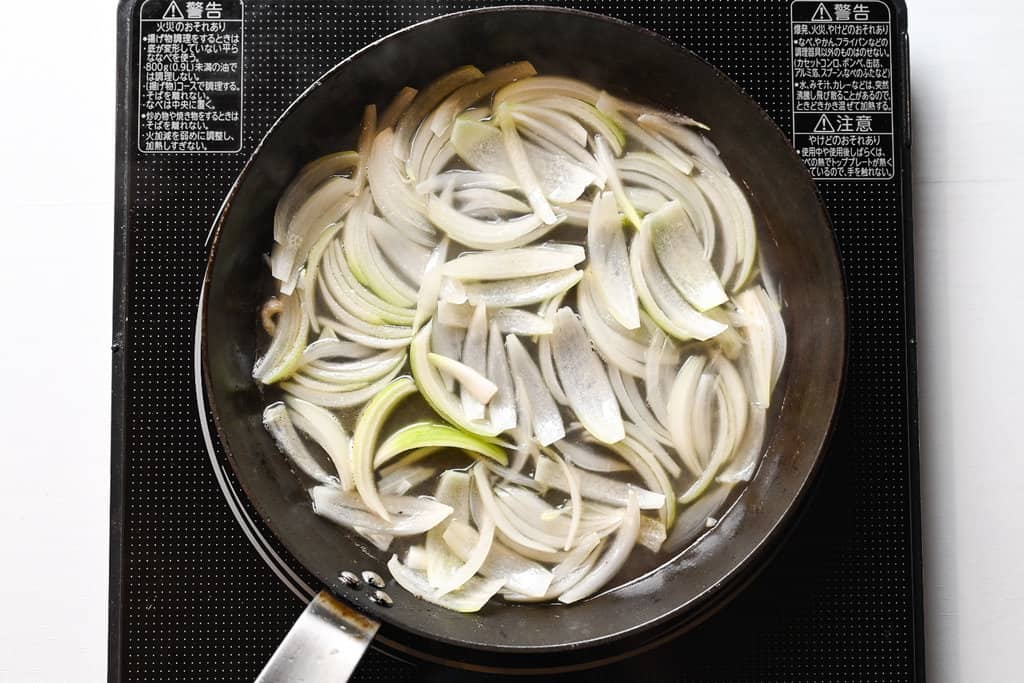
- If you already have leftovers, or if you want to make something more sophisticated, try making it with homemade dashi stock.
- If you want convenience with a clean flavor, make it with tea bag-style dashi packets.
- If you want to use flavor enhancers, the easiest way is to use dashi granules mixed with water.
If you want to make your own homemade dashi stock, check out my YouTube video.
Once the onions have softened, add soy sauce. Then, put the chicken pieces back into the simmering broth.
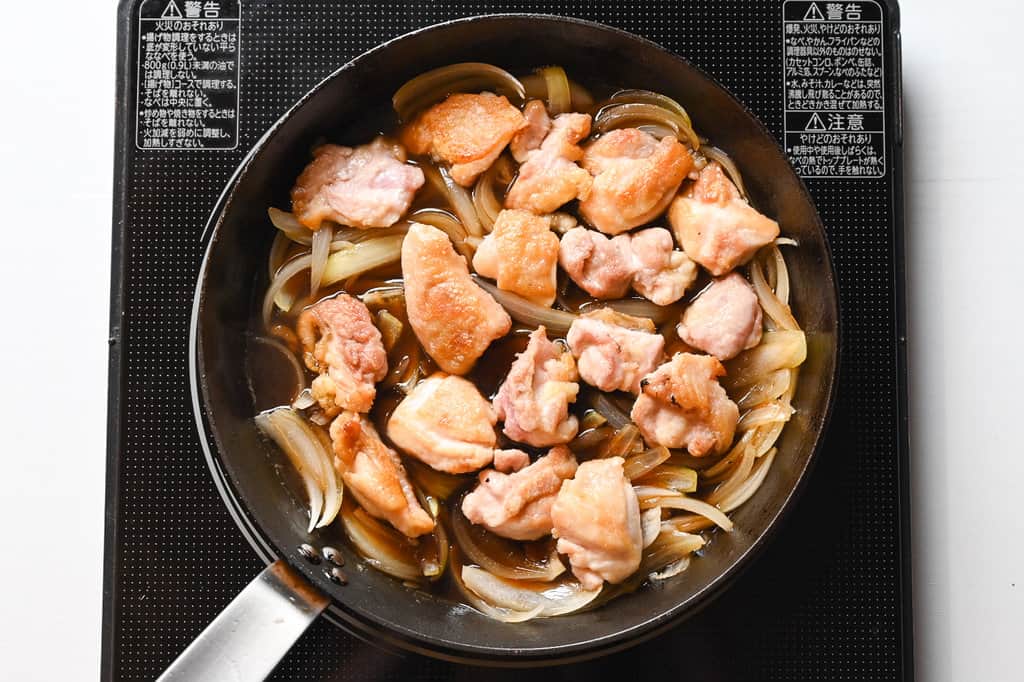
While the chicken finishes cooking, prepare your eggs. Separate the whites and yolks into different bowls.
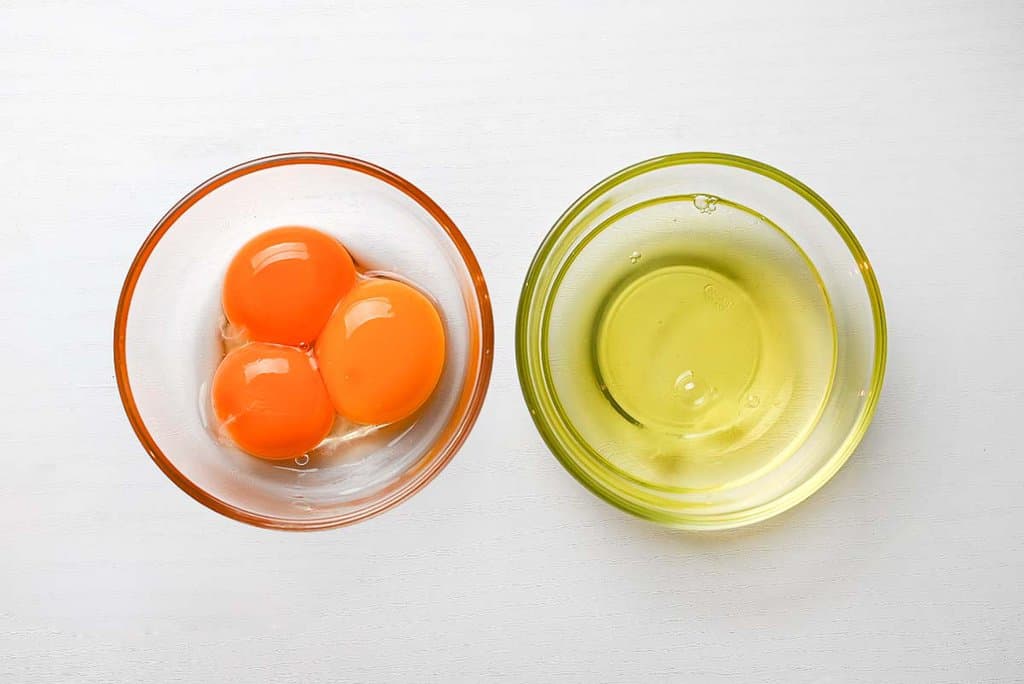
Egg yolks and egg whites have different coagulation temperatures (the temperature in which they firm up.) With that in mind, I add the egg white to the pan first, then whisk the yolk lightly and add it near the end. This also creates a better color on the top of the dish!
Using a circular motion, pour the egg whites around the pan, then cover and reduce heat to medium-low.
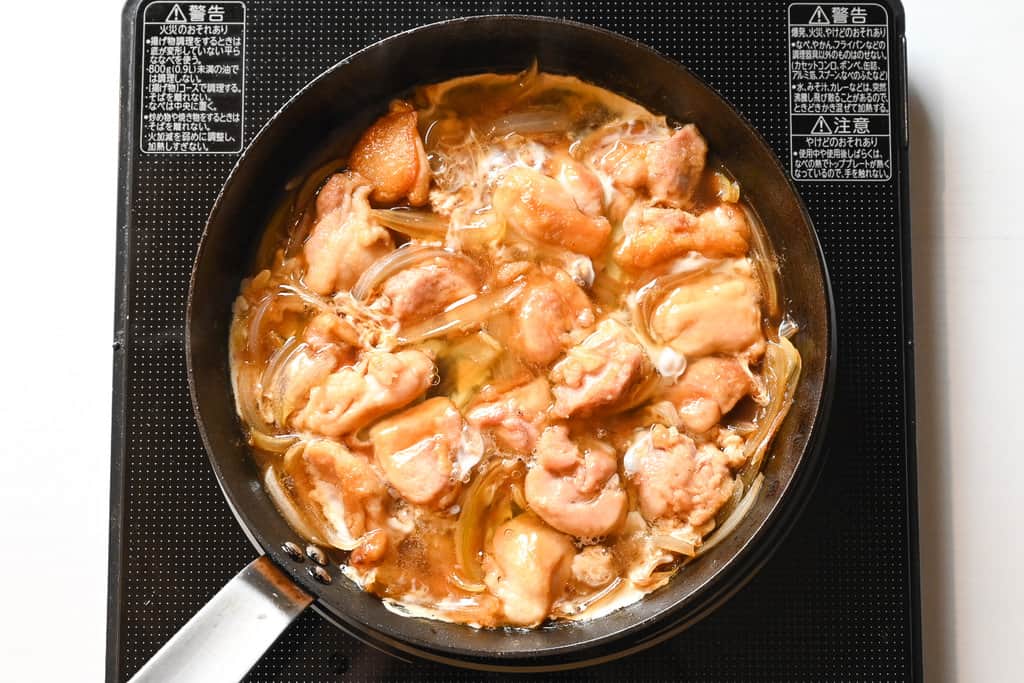
Cover with a lid and cook the egg whites for about 2-3 minutes, until barely set and turning opaque.

Remove the lid from the pan and reduce the heat to the lowest setting. Gently whisk the yolks just until combined (avoid creating bubbles), then pour it over the whites.
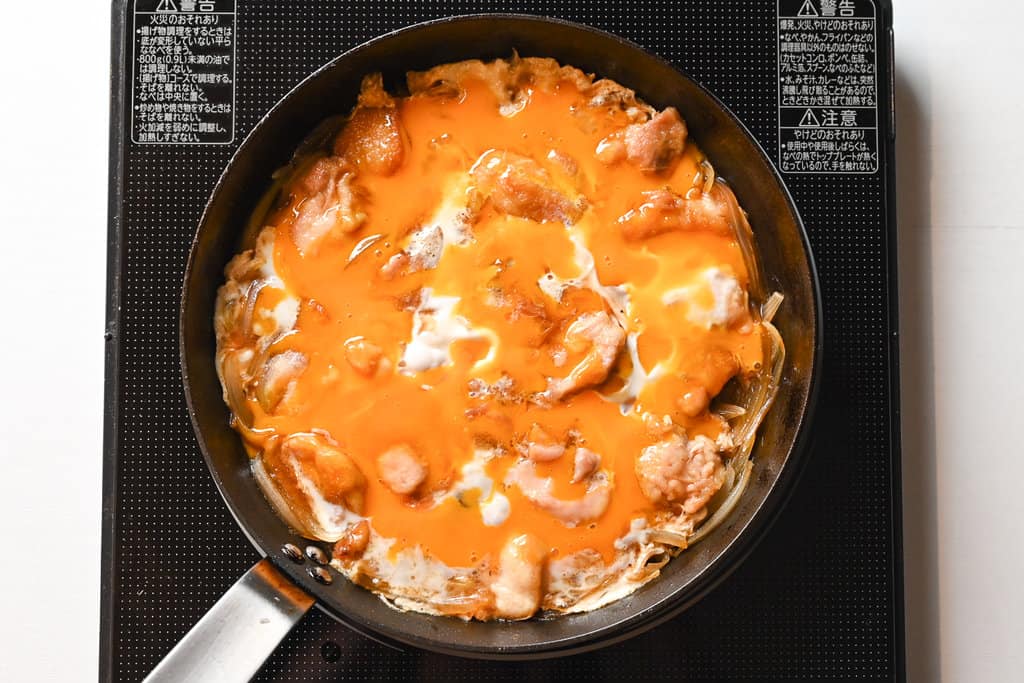
Cover again and steam for 1-2 minutes before turning off the heat completely. Authentic Oyakodon should have a slightly runny egg, but feel free to cook to your preferred doneness.
Divide your rice into bowls and the contents of the pan into equal portions. Place the chicken and egg on top of the rice. Try not to break the egg. Use a spatula or large serving spoon to scoop it out of the pan and onto the rice.

If you want to make authentic oyakodon, you’ve got to use Japanese short-grain rice. Here are the rice brands I recommend.
If you want to know how to cook rice, check out my YouTube guide.
Garnish with mitsuba (Japanese wild parsley) and shredded nori for fresh contrast and visual appeal.
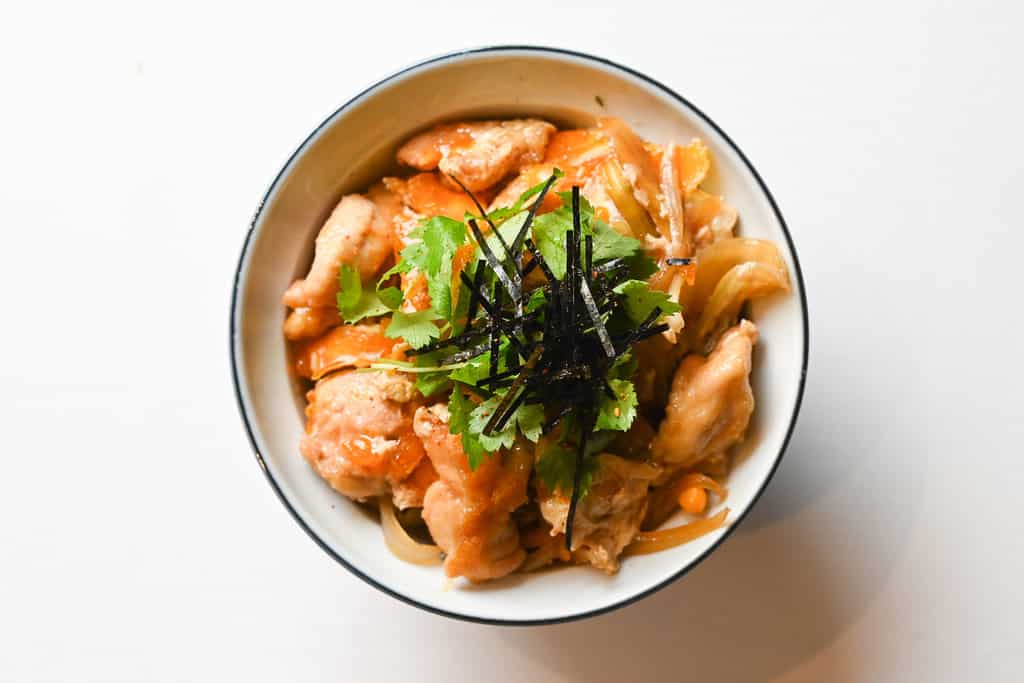
Enjoy! I recommend serving it with miso soup as a side dish.
Jump to Full Recipe MeasurementsEssential Tips & Tricks
- Use just a thin dusting of flour on the chicken – excessive coating prevents proper sauce absorption.
- Make sure the onions are soft and juicy before moving on to the next steps. Well-cooked onions have a better texture and release natural sweetness and depth into the broth.
- Separate the eggs! The yolks and whites have different coagulation temperatures, so adding them at different times ensures each part is cooked to perfection.
- Pour egg whites in a circular pattern for varied textures throughout.
- Serve immediately after cooking – eggs continue setting from residual heat.
- Use a wide spatula to transfer the contents of the pan without breaking the delicate egg layer.
- Japanese short-grain rice is essential for proper sauce absorption.
With these simple tips in mind, you’re set for success every time you make Oyakodon.
Meal Prep & Storage
Oyakodon is not well-suited for meal prep. The dish’s signature appeal comes from the delicate, half-set egg texture and immediate combination of hot rice with the chicken and egg mixture.
Instead, for quicker weeknight preparation, consider these component preparations:
- Dashi Base: Prepare homemade dashi stock ahead of time.
- Pre-Cut Ingredients: Slice onions and cut chicken into bite-sized pieces, storing separately in airtight containers for up to 24 hours.
- Use a Rice Cooker: If you can set your rice in advance, it’s one less thing to worry about!
For storage of leftovers (though not recommended), refrigerate components separately in airtight containers and consume within 24 hours.
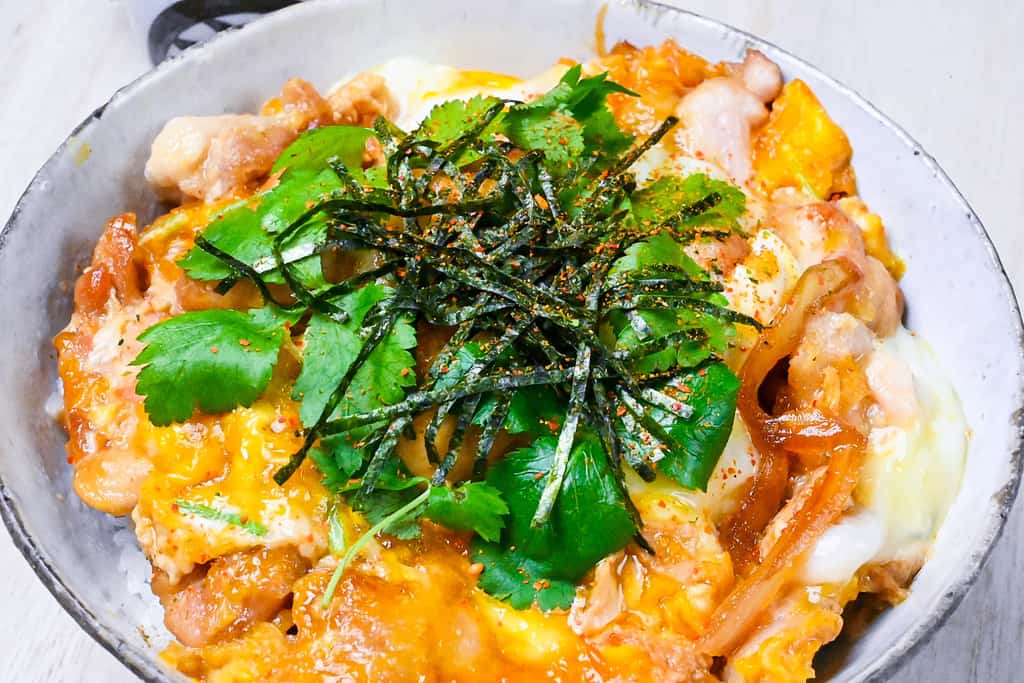
Serving Suggestions
FAQ
Although there are no official records, it is believed that Oyakodon appeared around the Meiji period (1868-1912) and originated from Tokyo or Osaka. The concept of the dish itself was born from pouring leftover chicken stew and raw egg over rice. It was a dish made up of leftovers, and these humble beginnings were the start of the delicious Oyakodon as we know it today! Here’s an interesting fact: Oyakodon is one of the oldest donburi dishes, only second to Gyudon, which is made with beef.
Absolutely. While thigh meat is traditional for its richness (higher inosinate content), breast meat works well with a few adjustments: marinate briefly in soy sauce before cooking, reduce cooking time by 1-2 minutes, and be especially careful not to overcook. If you’re looking for the softest texture with chicken breast, try using the velveting technique. You can find instructions for velveting the chicken breast in my Tori Chili recipe.
Definitely! The actual cooking time is about 20-25 minutes. For even faster prep: 1) Pre-measure seasonings into a small container on weekends, 2) Use pre-cut chicken thighs, and 3) Keep dashi handy. Using a rice cooker to cook your rice will also make life easier. With these prep steps, you can have authentic oyakodon ready in just 15-20 minutes.
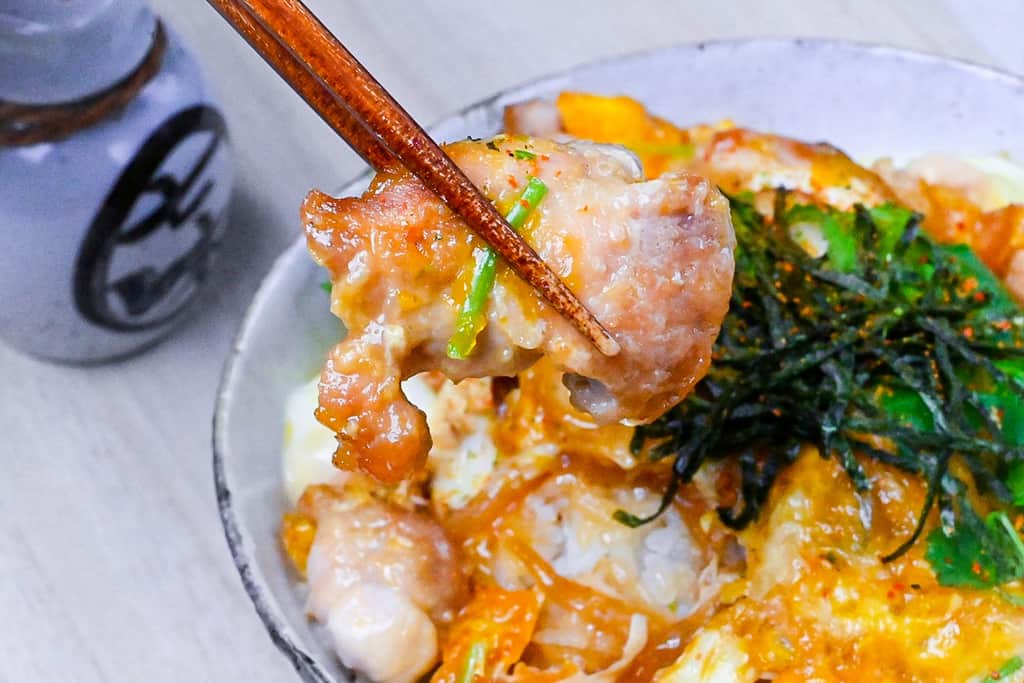
I hope you enjoy this Oyakodon recipe! If you try it out, I’d really appreciate it if you could spare a moment to let me know what you thought by giving a review and star rating in the comments below. It’s also helpful to share any adjustments you made to the recipe with our other readers. Thank you!
More Donburi Recipes
- “Karaage Don” Japanese Fried Chicken Donburi
- Sukiyaki Don (Sweet and Savory Simmered Beef Rice Bowl)
- Garlic Teriyaki Chicken bowl (Teriyaki chicken Donburi)
- Yakitori Donburi (Japanese Chicken Rice Bowl)
Want more inspiration? Explore my Donburi Recipe Roundup Post for a carefully selected collection of tasty recipe ideas to spark your next meal!
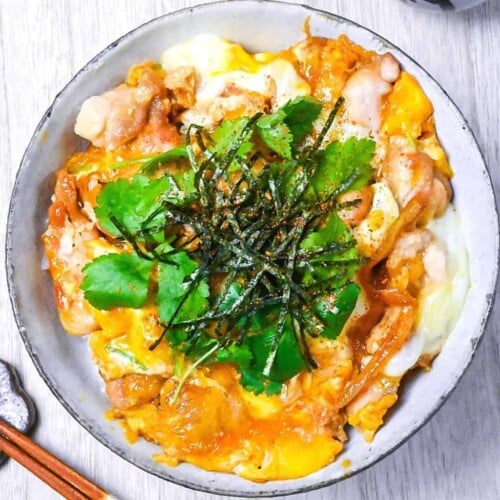
Ultimate Oyakodon (Japanese Egg and Chicken Bowl)
Ingredients
- 300 g boneless chicken thigh skin-on, bitesize pieces, cut across the grain for tenderness
- 1 pinch salt
- 1 tbsp all-purpose flour
- 1 tsp cooking oil neutral oil like vegetable, canola or rice bran
- 100 ml dashi stock homemade or instant granules work well
- ½ onion cut into thin wedges
- 3 tbsp mirin
- 1 tbsp light brown sugar
- 1 tsp Chinese-style chicken bouillon powder or regular chicken bouillon powder
- 2 tbsp Japanese soy sauce (koikuchi shoyu)
- 3 eggs room temperature
- kizami nori (shredded nori) optional garnish
- Japanese wild parsley (mitsuba) or chopped green onion, optional garnish
- 2 portions cooked Japanese short-grain rice If you don't have a rice cooker, you can use my method to cook Japanese style rice on the stove.
My recommended brands of ingredients and seasonings can be found in my Japanese pantry guide.
Can’t find certain Japanese ingredients? See my substitution guide here.
Instructions
- Cut 300 g boneless chicken thigh into bitesize pieces and place them in a bowl. Add 1 pinch salt and 1 tbsp all-purpose flour, and mix thoroughly until it is evenly coated.

- Heat a frying pan on medium and once hot, add 1 tsp cooking oil. Place the chicken thigh pieces in the pan in a single layer with the skin side facing down.

- Fry the chicken until the skin becomes crispy and then flip over. Sear on the other side, then turn off the heat and transfer the chicken to a plate.

- Wipe the pan with kitchen paper to remove the excess oil and add 100 ml dashi stock, 3 tbsp mirin, 1 tbsp light brown sugar, 1 tsp Chinese-style chicken bouillon powder to a pan and mix well. Place ½ onion in the broth and turn on the heat to medium. Simmer until the onion is softened.

- Once the onions are soft, pour 2 tbsp Japanese soy sauce (koikuchi shoyu) into the pan and add the chicken pieces back in, evenly spaced apart.

- Separate the whites and yolks of 3 eggs into two separate bowls.

- Whisk the egg whites and pour them around the pan. (Do not add the yolks yet.)

- Place a lid on top and cook for 3 minutes or until the whites are just starting to turn opaque.

- Reduce the heat to the lowest setting and remove the lid. Whisk the egg yolks and pour them around the pan. Place the lid back on and continue to cook in the steam until it reaches your preferred doneness. (Authentic oyakodon should have eggs that are only just cooked, slightly runny yolks are recommended.)

- Use a spatula to divide the egg into pieces that will fit on top of your serving bowls. Dish up 2 portions cooked Japanese short-grain rice, then use a spatula or large serving spoon to scoop the egg and chicken mixture onto the rice.

- Drizzle any leftover sauce in the pan evenly over each portion and garnish with kizami nori (shredded nori) and Japanese wild parsley (mitsuba). Enjoy!

Video
Notes
- Cook the onions thoroughly to release their natural sweetness and highlight their soft, melt-in-mouth texture!
- Add egg whites first to the pan and cook until firm.
- Add lightly whisked egg yolks near the end of cooking for optimal texture and color.
- Oyakodon doesn’t store well, but components can be prepped separately (sauce base, sliced onions, cut chicken) up to 24 hours ahead.
- Serving ideas: Authentic miso soup, Mushroom miso soup, Pickled cucumber, Pickled Napa cabbage.
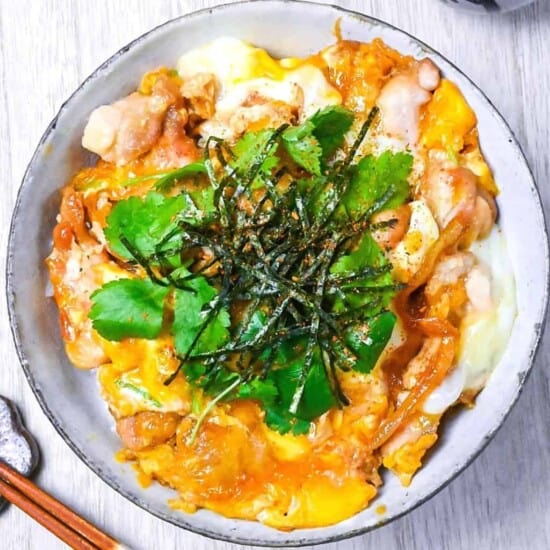






Best oyakodon recipe hands down. I’ve been scouring the internet for different kinds of oyakodon recipe. But this really recipe stands above the rest.
Can’t wait to cook more of your food!
Hi Joel,
Thank you so much for your kind words! It means a lot!
Yuto
Yummy n simple
Hi Marcelliana,
Thank you so much for trying this recipe! Looking great! I’m glad to hear you enjoyed it. 🙂
Yuto
I have also tried several recipes, what makes yours stand out is separating the eggs, a great idea!
Free range chicken from the south west of France, mitsuba cut fresh from the terrasse and Koshihikari from Niigata, what could be better 😉
Hi Tony,
Thank you for sharing your experience! You’re indeed cooking with the finest! I’m glad to hear the egg separation technique worked well! 🙂
Yuto
This is the best oyakodon recipe ever. Problem solved! – and I have tried many. Before, the chicken turned out too hard, too blonde, too dry, or onions too dark, too strong, too something, the dashi too much too little, the egg too raw too cooked – too many toos with little possibility to control the end result in the making. Now this here is the ultimate answer. (Picture shows a ‘deconstructed’ oyakodon / zosui because I had rice leftover from yesterday.)
Hi Isa,
Thank you so much for leaving your lovely comment here too! So happy to hear that you found this recipe the best! I also love how you creatively adapted it into a deconstructed style with your leftover rice! 🙂
Yuto
Am stress testing this recipe currently , made it five times in a row with various degrees of sloppiness . Turns out perfect every single time.
Thank you Yuto-san!!
Hi Isa,
Thank you so much for testing the recipe so thoroughly! Hearing that it works reliably even with different approaches is the greatest compliment a recipe developer could receive!
Yuto
… and repeat! Perfect as always.
Thank you for making my Oyakodon again, Isa! Looking delicious as always! 🙂
Perfect recipe! Delicious and comforting and easy to put together. Thank you for sharing!
Hi Ash,
Thank you for trying this dish! I’m so glad you found it both delicious and easy to make. Comments like yours make sharing recipes truly rewarding!
Yuto
Thanks for your tip of separating the eggs…. brilliant.
This is one of my favourite dinners.
I can’t get bonito flakes here so I use dried shiitake instead.
Hi Trish,
Thank you for trying this recipe! I’m happy the egg tip helped and I bet the shiitake adds amazing depth too! 🙂
Yuto
Mahalo will make this soon!
Thank you, Faith! I hope you will enjoy! 🙂
Oh my gosh! Was not expecting that. We cooked this up and given the limited ingredients we were thinking ‘boring rice with a dry omelette on top’
But NO WAY where did that flavour come from!
Outstanding and a new firm favourite simple dish to go to
Hi Peter,
Thank you so much for trying my oyakodon recipe too! I’m so happy it turned out to be a pleasant surprise and that it’s become a new favorite in your home! It means a lot! 😊
Yuto
Absolutely delicious! I used chicken breast and followed the instructions to not overcook. The chicken stayed moist the whole time. I added another egg than the recipe called for, just because we love eggs and I was using a huge pan. Also way easier than I anticipated. Made on a Tuesday night! This will be a go-to for sure from now on.
Hi Shannon,
Thank you for trying my oyakodon recipe! I’m really happy you enjoyed the recipe and made it your own with the extra egg. 🙂
Yuto
This was absolutely delicious! I came here from your YouTube channel. I’ve been wanting to make this for a while, but wasn’t sure if my husband would enjoy it. Turns out it’s also a 5 from him as well!
This is definitely going to be in my rotation because it’s an ultimate comfort food ❤️ Thank you so much for sharing the recipe!
Cheers from Utah state 🙂
Hi Ranae,
Thank you so much for trying this recipe and for taking the time to leave feedback from YouTube! That really means a lot. I’m so happy to hear it was a 5 from both you and your husband and that it’s going into your regular rotation! 🙂
Yuto